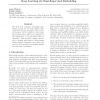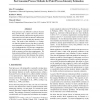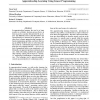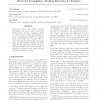78
Voted
ICML
2008
IEEE
16 years 1 months ago
2008
IEEE
We show how nonlinear embedding algorithms popular for use with shallow semisupervised learning techniques such as kernel methods can be applied to deep multilayer architectures, ...
115
Voted
ICML
2008
IEEE
16 years 1 months ago
2008
IEEE
Deep Belief Networks (DBN's) are generative models that contain many layers of hidden variables. Efficient greedy algorithms for learning and approximate inference have allow...
84
Voted
ICML
2008
IEEE
16 years 1 months ago
2008
IEEE
Point processes are difficult to analyze because they provide only a sparse and noisy observation of the intensity function driving the process. Gaussian Processes offer an attrac...
52
Voted
ICML
2008
IEEE
16 years 1 months ago
2008
IEEE
110
click to vote
ICML
2008
IEEE
16 years 1 months ago
2008
IEEE
In high-dimensional classification problems it is infeasible to include enough training samples to cover the class regions densely. Irregularities in the resulting sparse sample d...
86
Voted
ICML
2008
IEEE
16 years 1 months ago
2008
IEEE
In apprenticeship learning, the goal is to learn a policy in a Markov decision process that is at least as good as a policy demonstrated by an expert. The difficulty arises in tha...
100
Voted
ICML
2008
IEEE
16 years 1 months ago
2008
IEEE
Finding good representations of text documents is crucial in information retrieval and classification systems. Today the most popular document representation is based on a vector ...
ICML
2008
IEEE
16 years 1 months ago
2008
IEEE
Previous algorithms for learning lexicographic preference models (LPMs) produce a "best guess" LPM that is consistent with the observations. Our approach is more democra...
92
Voted
ICML
2008
IEEE
16 years 1 months ago
2008
IEEE
Semi-supervised learning aims at taking advantage of unlabeled data to improve the efficiency of supervised learning procedures. For discriminative models however, this is a chall...
90
Voted
ICML
2008
IEEE
16 years 1 months ago
2008
IEEE
Structured models often achieve excellent performance but can be slow at test time. We investigate structure compilation, where we replace structure with features, which are often...





